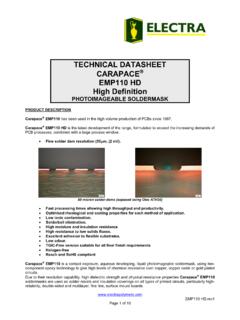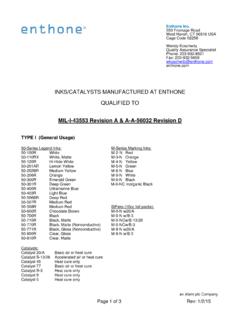Transcription of ENTHONE M SERIES - Allen Woods Group
1 TECHNICAL DATA SHEET ENTHONE M SERIES Technical Data Sheet Product Code: ###### Issue: 25 June 2014 Page 1 of 8 ENTHONE M SERIES Permanent Epoxy Marking Ink Product Code: ###### DESCRIPTION ENTHONE M- SERIES inks are permanent, two component, epoxy-based marking inks. They may be used with a selection of catalysts which cure at elevated and/or room temperatures. When properly applied and cured, ENTHONE M- SERIES inks have excellent adhesion to glass, metal and thermosetting plastics. They have excellent chemical and thermal resistance properties. ENTHONE M- SERIES marking inks are used in the electronic, aerospace, automotive, appliance and decorative packaging industries. Uses include the permanent marking of semiconductor components, printed circuit boards, connectors, dials, nameplates, panels, chassis, glass and thermoplastics.
2 READ ENTIRE TECHNICAL DATA SHEET BEFORE USING THIS PRODUCT PHYSICAL PROPERTIES COLOR NUMBERS AND MIX RATIOS Mix Ratios Catalyst Additions Parts by Weight per 100 Parts Ink Ink Number Color Recommended Catalyst All Catalysts (except Catalyst 5) Catalyst 5 Only M 2 N M 3 N M 4 N M 5 N M 6 N M 9 N M 0 N M 0 NC Red (Cadmium) Orange (Cadmium) Yellow (Cadmium) Green (Cadmium) Blue White Black 1 Inorganic Black * * * * * * * B-13/28 NR * Use any catalyst listed in Catalyst Description Section 1 Not intended for electrical applications TECHNICAL DATA SHEET ENTHONE M SERIES Technical Data Sheet Product Code: ###### Issue: 25 June 2014 Page 2 of 8 CATALYST DESCRIPTION Catalyst Description Cure Average Pot Life (hours) 20/A Basic air cure catalyst.
3 Cures at room temperature in 5 to7 days. Tack free after 1 to 2 hours. May also be heat cured. or Heat 2 B-3 Basic heat cure only catalyst. Higher cure temperatures decrease cure time. Heat 4 5 Long pot life. Excellent adhesion properties. Special mix ratios are required for this heat cure only catalyst (refer to Color Numbers and Mix Ratios Section). Heat 24 Max* B-13/28 Accelerated air cure catalyst. Cures at room temperature in 3 days. Shorter pot life. or Heat 1 45 Long pot life. This heat cure only catalyst contains adhesion promoters. Provides excellent adhesion to glass and metals with good water resistance. Slightly decreases solvent resistance. Heat 12 77 Adhesion promoting catalyst. Cures at room temperature in 5-7 days. Provides similar characteristics as Catalyst 45. Maximum adhesion is achieved by heat cure @ to oC (150 to 200 oF).
4 Or Heat 1 * Note: When using Catalyst #5 discard ink after 24 hours MAKE UP PROCEDURE MIXING INSTRUCTIONS Measure ink and catalyst at the proper mix ratio (refer to Color Numbers and Mix Ratios Section). Both the ink and catalyst should be weighed accurately. Excessive and insufficient amounts of catalyst are detrimental to cured ink film properties. Mix thoroughly without introducing excessive amounts of air. Avoid the use of paper or wax coated cups. Stir from bottom of the container. OBSERVE INDUCTION PERIOD All catalysts: 30 minutes Catalysts 45 and 5: 60 minutes Allow ink/catalyst mixture to stand for at least 30 minutes prior to application. This provides an induction period ensuring a homogenous mix of resin and catalyst and allows any entrapped air to escape from the mixture. The average pot life begins after the induction period.
5 TECHNICAL DATA SHEET ENTHONE M SERIES Technical Data Sheet Product Code: ###### Issue: 25 June 2014 Page 3 of 8 APPLICATION ENTHONE M SERIES inks may be applied by hand stamping, machine marking, screen printing, spraying, and roller printing. To ensure optimum adhesion, it is imperative that the surface to be printed is clean and free of any residues or particulates. OPTIONAL ADDITIONS Additions of thinner or flow agents should always follow the induction period. If the induction period is not observed, the thinner or flow agent may interfere with the catalyzation process and could affect the final cured properties. POT LIFE Pot life will vary with the catalyst used (refer to Catalyst Description Section). To avoid waste, mix only an amount which can be consumed before the end of the pot life. High ambient temperatures will shorten the pot life.
6 Solvent additions will increase the pot life. Catalyst 45 and 5 have the longest pot life (12 hr and 24 hr max respectively), however cure temperature requirements must be observed (see Recommended Cure Section). Catalyst # 5 has special pricing (Contact your local distributor for pricing information). SHELF LIFE ENTHONE M SERIES Inks: 3 years from date of manufacture All Catalysts: 2 years from date of manufacture NOTE: Catalysts are hygroscopic. Containers should be kept tightly closed after each use to prevent moisture contamination. METHODS OF APPLICATION MACHINE MARKING Minimum pressure is recommended for transfer-pad or flat-bed printers. Adjust rollers to mL ( mm) clearance prior to the addition of ink. Increase the depth of the ink on the roll feeds until ink is transferred. Additions of AD2003 retarder may be used during the print run.
7 HAND STAMPING Use a brayer to roll out a thin film of ink onto a glass or metal plate. Transfer the ink from plate to the part with a rubber, neoprene, or urethane stamp. Minimum pressure provides a sharp image definition. Disposable stamp pads made of finely textured polyurethane foam or foam rubber may also be used. Because the ink begins to solidify at the end of its pot life, stamp pads cannot be reused. TECHNICAL DATA SHEET ENTHONE M SERIES Technical Data Sheet Product Code: ###### Issue: 25 June 2014 Page 4 of 8 SCREEN PRINTING Monofilament polyester fabrics with a mesh count of 180 to 330 may be used. Mesh tension should be to the fabric manufacturer s recommendations. Stencils may be applied by direct, indirect, or direct/indirect methods. Squeegee material should be 70 to 80 durometer, sharp and free of nicks.
8 Squeegee durometer, pressure, angle and print speed should be adjusted according to overall printing parameters to ensure high quality print definition. SPRAYING Following the induction period, thin with AD2002 or a blend of 80% PM glycol ether and 20% methyl isobutyl ketone at 25 to 40% by volume, depending on air pressure and orifice of spray unit. Thinner additions will extend the pot life considerably. THINNING If thinning is required, add small amounts of AD2001 thinner. Additions should be made after the induction period. Thinner additions extend the pot life. RETARDING Small amounts of AD2003 or carbitol acetate are recommended. Additions should only be made after the induction period has been observed. CLEANING / REMOVAL Clean equipment before the ink dries and partially cures. Use ENTHONE Screen Cleaners SC1710, PC7804, or PC7886.
9 Requires post water rinsing to remove surfactants. Localized Equipment Cleaning: Use AD2001, AD2002, AD2003, or other strong oxygenated solvents without surfactants that require post water rinsing. TECHNICAL DATA SHEET ENTHONE M SERIES Technical Data Sheet Product Code: ###### Issue: 25 June 2014 Page 5 of 8 RECOMMENDED CURE CURE SCHEDULE 210 -200 190 180 170 160 150 140 130 120 110 100 90 80 70 CURE TEMPERATURE, CCURE TIME, MINUTES5 15 30 60 75 90catalyst # 5all standard catalysts except catalyst # 515 min. @ 150 C(300 F)5 min. @ 205 C (400 F)10 min. @ 177 C (350 F)30 min. @ 121 C (250 F)60 min. @ 93 C (200 F)90 min. @ 79 C (175 F) TECHNICAL DATA SHEET ENTHONE M SERIES Technical Data Sheet Product Code: ###### Issue: 25 June 2014 Page 6 of 8 ADDITIONAL CURE INFORMATION Cure schedules denote times/temperatures for curing ink film only.
10 Allow additional time for the substrate to reach the actual cure temperature. Convection ovens should have sufficient exhaust and air movement to ensure solvent removal. Cure temperatures above 79 C (175 F) are required for Catalysts B-3 or 45. Cure temperatures above 93 C (200 F) are required for Catalyst 5. Air cure Catalysts 20/A, B-13/28 and 77 provide a tack-free ink surface after 1 to hours, depending on the ink film thickness. A tack-free surface is not an indication of cure. When using an ambient cure, articles should be racked and/or spaced to allow air circulation for the designated cure schedule. Do not box, bag, or package until the recommended cure time has been observed. Hot air blasts can be used to expedite handling. These catalysts may be fully or partially heat cured. Heat cure enhances the final cured properties.






